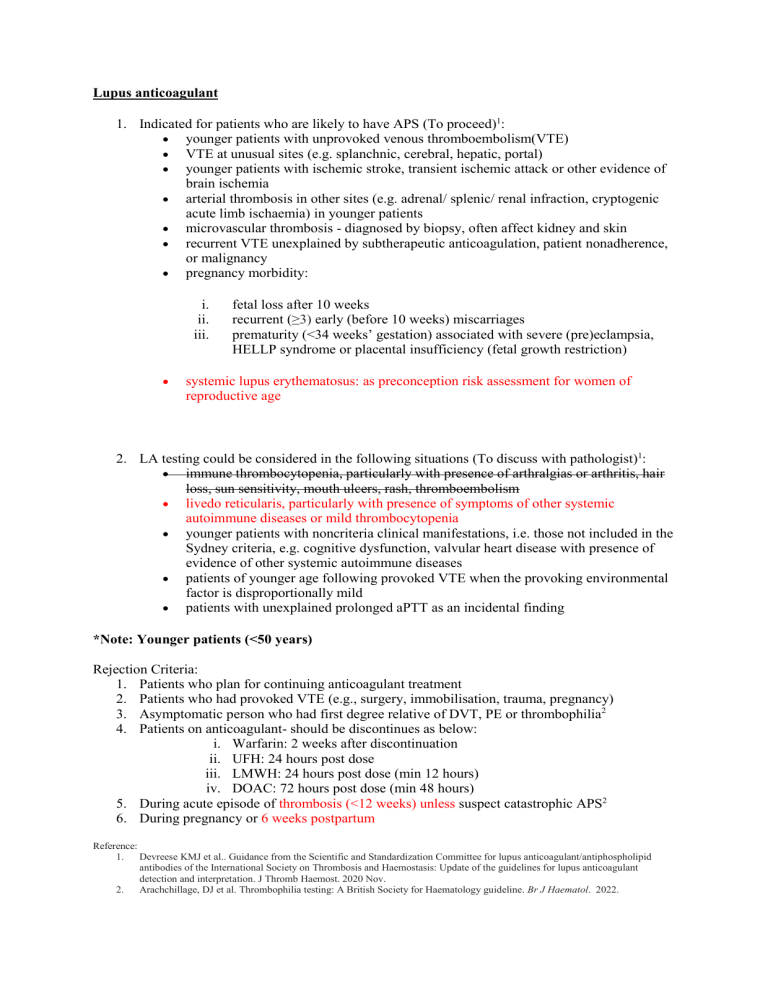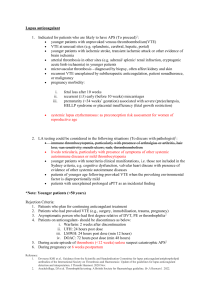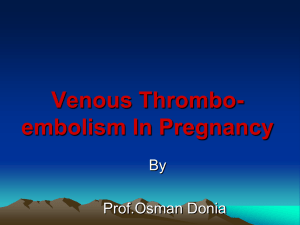
Lupus anticoagulant 1. Indicated for patients who are likely to have APS (To proceed)1: younger patients with unprovoked venous thromboembolism(VTE) VTE at unusual sites (e.g. splanchnic, cerebral, hepatic, portal) younger patients with ischemic stroke, transient ischemic attack or other evidence of brain ischemia arterial thrombosis in other sites (e.g. adrenal/ splenic/ renal infraction, cryptogenic acute limb ischaemia) in younger patients microvascular thrombosis - diagnosed by biopsy, often affect kidney and skin recurrent VTE unexplained by subtherapeutic anticoagulation, patient nonadherence, or malignancy pregnancy morbidity: i. ii. iii. fetal loss after 10 weeks recurrent (≥3) early (before 10 weeks) miscarriages prematurity (<34 weeks’ gestation) associated with severe (pre)eclampsia, HELLP syndrome or placental insufficiency (fetal growth restriction) systemic lupus erythematosus: as preconception risk assessment for women of reproductive age 2. LA testing could be considered in the following situations (To discuss with pathologist)1: immune thrombocytopenia, particularly with presence of arthralgias or arthritis, hair loss, sun sensitivity, mouth ulcers, rash, thromboembolism livedo reticularis, particularly with presence of symptoms of other systemic autoimmune diseases or mild thrombocytopenia younger patients with noncriteria clinical manifestations, i.e. those not included in the Sydney criteria, e.g. cognitive dysfunction, valvular heart disease with presence of evidence of other systemic autoimmune diseases patients of younger age following provoked VTE when the provoking environmental factor is disproportionally mild patients with unexplained prolonged aPTT as an incidental finding *Note: Younger patients (<50 years) Rejection Criteria: 1. Patients who plan for continuing anticoagulant treatment 2. Patients who had provoked VTE (e.g., surgery, immobilisation, trauma, pregnancy) 3. Asymptomatic person who had first degree relative of DVT, PE or thrombophilia2 4. Patients on anticoagulant- should be discontinues as below: i. Warfarin: 2 weeks after discontinuation ii. UFH: 24 hours post dose iii. LMWH: 24 hours post dose (min 12 hours) iv. DOAC: 72 hours post dose (min 48 hours) 5. During acute episode of thrombosis (<12 weeks) unless suspect catastrophic APS2 6. During pregnancy or 6 weeks postpartum Reference: 1. Devreese KMJ et al.. Guidance from the Scientific and Standardization Committee for lupus anticoagulant/antiphospholipid antibodies of the International Society on Thrombosis and Haemostasis: Update of the guidelines for lupus anticoagulant detection and interpretation. J Thromb Haemost. 2020 Nov. 2. Arachchillage, DJ et al. Thrombophilia testing: A British Society for Haematology guideline. Br J Haematol. 2022. D-dimer Indications: 1. Suspected DVT/PE in patients with low clinical probability1: DVT Wells score <2 PE Wells score ≤ 4 (Please state the Wells score with clinical features scored) 2. Suspected PE in pregnancy: Follow YEARS algorithm2 3. Diagnosis of DIVC 4. Probable and confirmed severe Covid-19 disease (CAT4 and5) Rejection Criteria: 1. Request with no clinical history or PE/ Well score to explain the indication Reference: 1. NICE Guidelines. Venous thromboembolic diseases: diagnosis, management, and thrombophilia testing. March 2020. 2. van der Pol LM et. al. Pregnancy-Adapted YEARS Algorithm for Diagnosis of Suspected Pulmonary Embolism. NEJM. 2019. 3. NIH. The Covid-19 Tretament Guildlines Panel’s Statement on Anticoagulation in Hospitalised Patients with Covid-19. Updated December1, 2022. DVT Wells score Clinical feature Active cancer (treatment ongoing, within 6 months, or palliative) Paralysis, paresis, or recent plaster immobilisation of the lower extremities Recently bedridden for 3 days or more, or major surgery within 12 weeks requiring general or regional anaesthesia Localised tenderness along the distribution of the deep venous system Entire leg swollen Calf swelling at least 3cm larger than asymptomatic side Pitting oedema confined to the symptomatic leg Collateral superficial veins (non-varicose) Previously documented DVT An alternate diagnosis is at least as likely as DVT Points 1 1 1 1 1 1 1 1 1 -2 PE Wells score Clinical feature Clinical signs and symptoms of DVT (minimum of leg swelling and pain with palpation of the deep veins) An alternate diagnosis is less likely than PE Heart rate more than 100 beats per minute Immobilisation for more than 3 days or surgery in the previous 4 weeks Previous DVT/PE Haemoptysis Malignancy (on treatment, treated in the last 6 months, or palliative) Points 3 3 1.5 1.5 1.5 1 1






